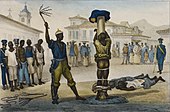
Back بتر Arabic Amputación AST Amputasiya Azerbaijani Ампутацыя Byelorussian Ампутация Bulgarian Amputacija BS Ампутаци BXR Amputació Catalan Amputace Czech Amputation Danish
| Amputation | |
|---|---|
| Other names | Severed limb |
 | |
| An amputee running with a blade prosthetic | |
| Specialty | Surgery
Physical medicine and rehabilitation Emergency medicine |
| Complications | Phantom limb syndrome |
| Causes | Trauma or intentional as part of surgery and sometimes corporal punishment. |
| Part of a series on |
| Corporal punishment |
|---|
 |
| By place |
| By implementation |
| By country |
| Court cases |
| Politics |
| Campaigns against corporal punishment |
| Criminal procedure |
|---|
| Criminal trials and convictions |
| Rights of the accused |
| Verdict |
| Sentencing |
|
| Post-sentencing |
| Related areas of law |
| Portals |
|
Amputation is the removal of a limb by trauma, medical illness, or surgery. As a surgical measure, it is used to control pain or a disease process in the affected limb, such as malignancy or gangrene. In some cases, it is carried out on individuals as a preventive surgery for such problems. A special case is that of congenital amputation, a congenital disorder, where fetal limbs have been cut off by constrictive bands. In some countries, judicial amputation is currently used to punish people who commit crimes.[1][2][3][4] Amputation has also been used as a tactic in war and acts of terrorism; it may also occur as a war injury. In some cultures and religions, minor amputations or mutilations are considered a ritual accomplishment.[5][6][7] When done by a person, the person executing the amputation is an amputator.[8][9] The oldest evidence of this practice comes from a skeleton found buried in Liang Tebo cave, East Kalimantan, Indonesian Borneo dating back to at least 31,000 years ago, where it was done when the amputee was a young child.[10]
- ^ Fathi, Nazila (2008-01-11). "Spate of Executions and Amputations in Iran". The New York Times. Retrieved 2021-06-27.
- ^ Chuback, Jennifer E. (March 2005). Whitelaw, W.A. (ed.). The history of rhinoplasty. 14th Annual History of Medicine Days. Calgary, Alberta, Canada: University of Calgary. pp. 10–15 – via ResearchGate.
- ^ Kocharkarn W (Summer 2000). "Traumatic amputation of the penis" (PDF). Brazilian Journal of Urology. 26: 385–389. Archived (PDF) from the original on 2022-10-09 – via Official Journal of the Brazilian Society of Urology.
- ^ Peters R (2005). Crime and Punishment in Islamic Law: Theory and Practice from the Sixteenth to the Twenty-First Century. Cambridge University Press. ISBN 9780521792264.
- ^ Bosmia AN, Griessenauer CJ, Tubbs RS (July 2014). "Yubitsume: ritualistic self-amputation of proximal digits among the Yakuza". Journal of Injury and Violence Research. 6 (2): 54–6. doi:10.5249/jivr.v6i2.489. PMC 4009169. PMID 24284812.
- ^ Kepe T (March 2010). "'Secrets' that kill: crisis, custodianship and responsibility in ritual male circumcision in the Eastern Cape Province, South Africa". Social Science & Medicine. 70 (5): 729–35. doi:10.1016/j.socscimed.2009.11.016. PMID 20053494.
- ^ Grisaru N, Lezer S, Belmaker RH (April 1997). "Ritual female genital surgery among Ethiopian Jews". Archives of Sexual Behavior. 26 (2): 211–5. doi:10.1023/a:1024562512475. PMID 9101034. S2CID 32053425.
- ^ "Amputator". Merriam-Webster. Retrieved 28 June 2021.
- ^ "Amputee". Merriam-Webster. Retrieved 28 June 2021.
- ^ Maloney, T.R.; Dilkes-Hall, I.E.; Vlok, M (2022). "Surgical amputation of a limb 31,000 years ago in Borneo". Nature. 609 (7927): 547–551. Bibcode:2022Natur.609..547M. doi:10.1038/s41586-022-05160-8. PMC 9477728. PMID 36071168.
© MMXXIII Rich X Search. We shall prevail. All rights reserved. Rich X Search